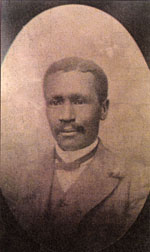Rosamond, Ca. 93560
The Unofficial Website
![]()
Local History - Charles Graves
 ROSAMOND
(AV Press, Jan. 1, 2008): Born into slavery, Charles A. Graves came west
after the Civil War, started a cattle ranch in the Antelope Valley and became a
leading citizen of Rosamond, building its first school and serving as its
postmaster.
ROSAMOND
(AV Press, Jan. 1, 2008): Born into slavery, Charles A. Graves came west
after the Civil War, started a cattle ranch in the Antelope Valley and became a
leading citizen of Rosamond, building its first school and serving as its
postmaster.
Graves was born in Kentucky on Feb. 26, 1856. His father was killed during the Civil War, and Graves spent a few years with a cousin in Kentucky.
After securing a small payment of money, he headed west looking for a place to raise cattle.
At first, he walked. Then he rode freight and passenger trains on the Southern Pacific Railroad, which passed through the Antelope Valley.
Graves arrived in Rosamond in 1882, according to an article in the Antelope Valley Heritage Foundation's Reflections Winter 1995 Journal.
He walked into the desert, toward the Tehachapi Mountains until he came across green grass and a spring. “It looked like a good place to raise cattle," according to his daughter Katherine in a 1996 interview with the Valley Press.
Graves homesteaded 640 acres, of which 160 acres was the property at today's Rosamond Boulevard and 30th Street West. At the time, Rosamond Boulevard was a dirt road. “We called it Washboard Avenue because it was so rough," said Katherine.
Graves built a small home, barns, and other buildings. As his prosperity grew, he hired several cowhands, a Chinese cook and wranglers.
In 1896, he became Rosamond's sixth United States Postmaster, possibly due to his skill as a horseman, because the mail then was delivered on horseback. According to a 1995 article by Rich Breault, Graves received "the post office's whopping inventory of $8.90." He held this position until 1903.
When gold was discovered in the area, Graves staked two claims, which he named Home Number 1 and Home Number 2, because they were close to his home.
After several years of loneliness, Graves decided to go on the search for a wife. "There weren't exactly large pickings here especially when you're black,” granddaughter Betty Price said in 1995. Graves placed advertisements in several newspapers and corresponded with the woman who wrote him.
In 1900, he took a train to Kansas City and married a woman named Cordia Anita Roberts. She was a school teacher and college graduate, a great accomplishment for a woman of her time. Together they had six children: Charles, Elizabeth, James, Robert, Mary and Katherine.
"Cordia Graves' training as a teacher meant that education was always very important in the Graves household. Their children first learned to read by a kerosene lamp,” Chris Christopher wrote in the Antelope Valley Heritage Foundation's Winter 1995 journal.
As Rosamond gained more families with children, Graves, in 1908, built a one‑room school on his property at what is now 35th street West and Rosamond Boulevard. Kern County later built a school on the same property.
Education was so important to Graves because he came from slavery, where reading and writing by slaves was unheard of, his granddaughter said.
“Education has always been important in the family," Price said in a 2006 interview. Graves' daughter, Katherine, graduated from Antelope Valley High School in 1928. She is believed to be the first African-American to graduate from there. Son Robert Graves was elected twice as the head of the Southern Ken Unified School District.
Today, the Graves family is still remembered in Rosamond. Charles Graves’ picture hangs in the Rosamond Post Office and the Rosamond High School foot ball field is named for Robert Graves.
Compiled by Intern Heather Muster ©2008 AV Press